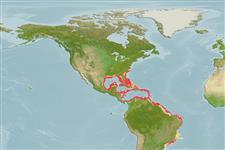Classification / Names
Common names from other countries
Main reference
Size / Weight / Age
Max length : 125 cm TL male/unsexed; (Ref. 26340); common length : 50.0 cm TL male/unsexed; (Ref. 5217); max. published weight: 23.0 kg (Ref. 9710); max. reported age: 25 years (Ref. 5222)
Length at first maturity
Lm 50.0, range 35 - 98 cm
Environment
Marine; reef-associated; non-migratory; depth range 5 - 330 m (Ref. 13442), usually 70 - 330 m (Ref. 13442)
Climate / Range
Subtropical, preferred 26°C (Ref. 107945); 35°N - 27°S, 98°W - 33°W (Ref. 5222)
Distribution
Western Atlantic: North Carolina, USA to southern Brazil, including the Gulf of Mexico, Caribbean, and Bermuda; strays occur north to Massachusetts.
Countries | FAO areas | Ecosystems | Occurrences | Introductions
Short description
Dorsal
spines
(total): 11;
Dorsal
soft rays
(total): 16-17;
Anal
spines: 3;
Anal
soft rays: 8 - 10. Color of head and body dark reddish brown, shading to pink or reddish below. Opercle with 3 flat spines, the middle one being the largest. Vertical fins angulate in larger fish. Pelvic fins shorter than pectorals and inserted slightly behind ventral and pectoral-fin base. Bases of soft dorsal and anal fins covered with scales and thick skin. No saddle on caudal peduncle. Interspinous membranes not incised (Ref. 26938); head length 2.3-2.5 times in SL; convex interorbital; subangular preopercle, serrae at angle slightly enlarged; straight upper edge of operculum; posterior and anterior nostrils subequal (Ref. 89707).
IUCN Red List Status (Ref. 115185)
Human uses
Fisheries: commercial; gamefish: yes; aquarium: public aquariums
More information
ReferencesAquacultureAquaculture profileStrainsGeneticsAllele frequenciesHeritabilityDiseasesProcessingMass conversion
Tools
Special reports
Download XML
Internet sources
Estimates of some properties based on models
Phylogenetic diversity index
PD50 = 0.5000 many relatives (e.g. carps) 0.5 - 2.0 few relatives (e.g. lungfishes)
Trophic Level
3.5 ±0.5 se; Based on diet studies.
Resilience
Medium, minimum population doubling time 1.4 - 4.4 years (K=0.1-0.18; tm=4-6; tmax=25; Fec=1.4 million)
Vulnerability
High vulnerability (64 of 100)
Price category
